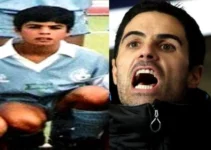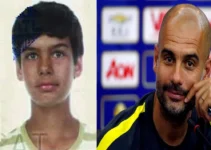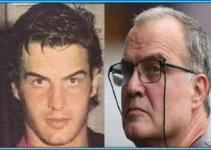A Legend like Ruud van Nistelrooy is the product of a football god. Once upon a time, on the 1st day of July 1976, a football god broadly looked at the Netherlands with a mighty smile on his face. Among almost five hundred children born that day, two boys were selected and given a rare gift by the gods. In Noord-Brabant, a province in the south of the Netherlands, the Van Nistelrooij family was also blessed with a baby boy: Rutgerus Johannes Martinus van Nistelrooij. He became known to the world as Ruud van Nistelrooy. And, on that same day, in Amsterdam, the birth of Patrick Stephan Kluivert was celebrated. These two boys, Patrick Kluivert and Ruud van Nistelrooy, born on the same day, would go on to be the Jewel of World Football. Our focus here is to tell Ruud’s story as we unfold events from his childhood to the moment he achieved a meteoric rise in the beautiful game.
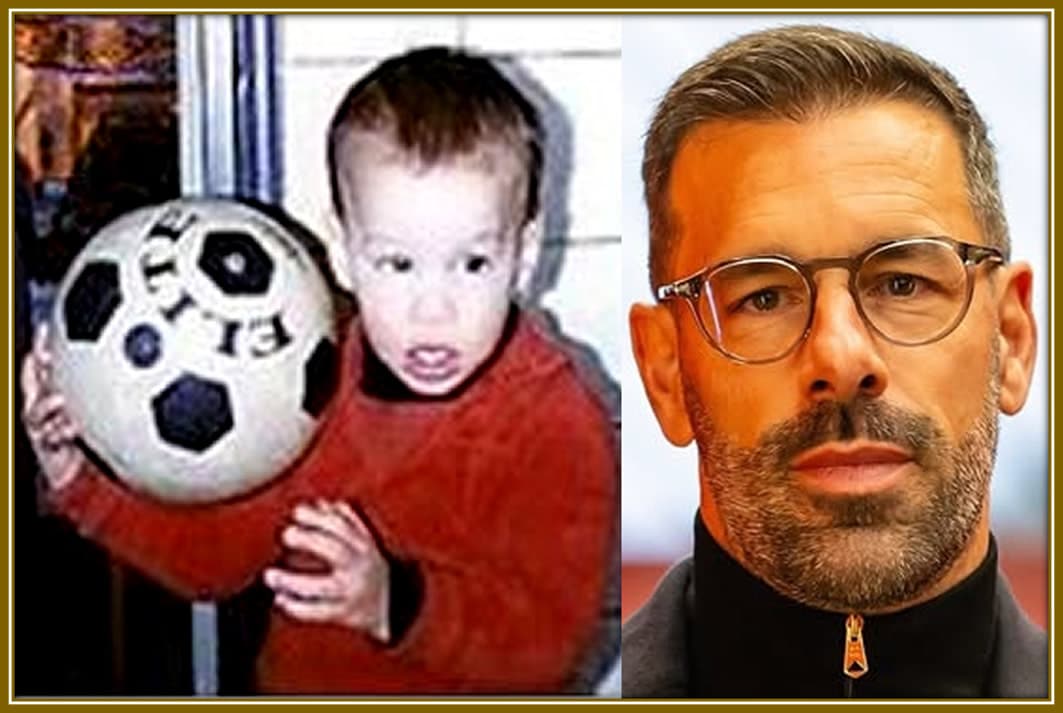
A Deep Dive into Ruud van Nistelrooy’s Life: From Childhood to Fame
Preamble:
We hope to increase your interest in reading football autobiographies as we engage you with the story of one of football’s most celebrated strikers. To begin right away, let’s unveil this gallery that tells his story from being that baby wonder, then progressing to that little Noord-Brabant boy with huge ambitions and then to the moment he became one of the world’s most feared strikers. Indeed, Ruud van Nistelrooy has truly come a long way in both his life and career journey.

The Journey of Ruud van Nistelrooy: From His Humble Beginnings to Becoming a Football Legend. Image Credit: Nooitgedachtgeffen, Instagram/rvnistelrooij/
Childhood Story:
For starters, in his Biography reading, he bears the nicknames, which are The Ruud Devil, Van The Man, and Van Gol. His full name are Rutgerus Johannes Martinus van Nistelrooij. The Manchester United Football Legend was born on the 1st day of July 1976 to Dutch parents at his birthplace of Oss, Netherlands. Ruud is one of three children, himself, a brother and a sister, born to his parents, one of whom is pictured here. On this day, November 29th 2018, when Nistelrooy invited his mum to one of PSV’s Champions League nights, fans trooped to his Instagram after the photo was uploaded to heap praise on his mum for giving them one of football’s greatest goal poachers of all time.

A heartwarming moment as fans were glad to see Ruud van Nistelrooy’s mum attending a PSV Champions League game and then praising her for giving birth to one of the game’s most feared strikers. Image Credit: Instagram/rvnistelrooij
Growing Up Years:
Ruud van Nistelrooy is not the only child in his family. As the firstborn and eldest son, he shares a close bond with his siblings. He grew up alongside his sister, Anneke van Nistelrooij, and a younger brother whose name is Ron van Nistelrooij. For his 41st birthday, Ruud celebrated with the people who know him best—his siblings and parents. Anneke took the lead in organizing a heartfelt party to honour her brother, not only for his contributions to football but also for the way he has uplifted their family. Their enduring support and love have been a constant in Ruud’s life, both on and off the pitch.
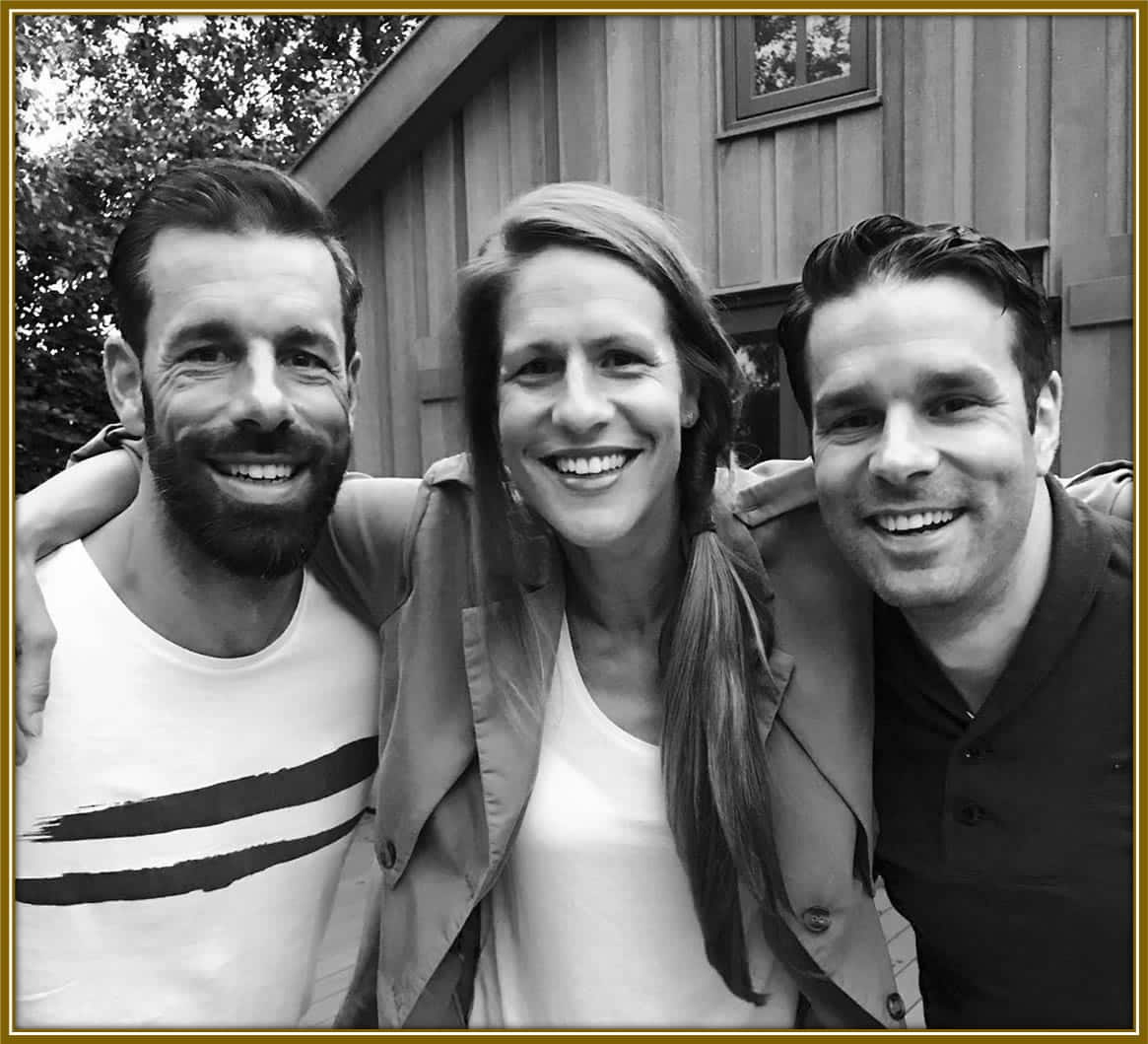
Here, he celebrates his 41st birthday surrounded by his beloved siblings, Anneke and his younger brother. Image: Instagram/rvnistelrooij
Ruud van Nistelrooy Early Years in Football:
As a young boy, Ruud van Nistelrooy had a deep love for sports. Football wasn’t his only interest—he excelled in tennis and gymnastics too. These activities filled his school days and free time. Over time, he realized football brought him more joy, especially because it allowed him to connect with more friends through the game. Gradually, football became his main focus, overtaking his passion for tennis and gymnastics. This early shift marked the beginning of his journey toward becoming one of the most iconic footballers.
Van Nistelrooy’s journey into football started humbly, developing his skills little by little. He began playing on the streets before joining the Nooit Gedacht football club. His father often accompanied him, dropping him off at training sessions. However, Ruud rarely saw his dad watching him play. Instead, his father would stand on another field, casually kicking a ball with friends, waiting for Ruud to finish before they headed home together. These quiet yet supportive moments highlight the strong bond between father and son during Ruud’s early footballing days.
Even decades after Ruud van Nistelrooy left Nooit Gedacht, the memories of his early days there remain vivid. These moments include time spent with his coach and teammates, who played an essential role in shaping his foundation in football.
In his childhood team’s memorable team photo:
Top row, left to right: Brother of Griensven (trainer), Martijn van Loosbroek, Ruud van Nistelrooij, Mark Beekmans, Maikel Schuurmans, Eelco Vogels, and Rikkie van Rooij.
Bottom row, left to right: Marco v/d Kamp, Eric Romme, Aldo van Griensven, Johan van Erp, Maikel Hondong, Niels de Visser, and Erwin Romme.
These early connections and friendships were pivotal in Ruud’s journey from a young boy with a passion for the game to a globally recognized football legend. These were the early days of a boy who would grow into one of football’s greatest strikers.
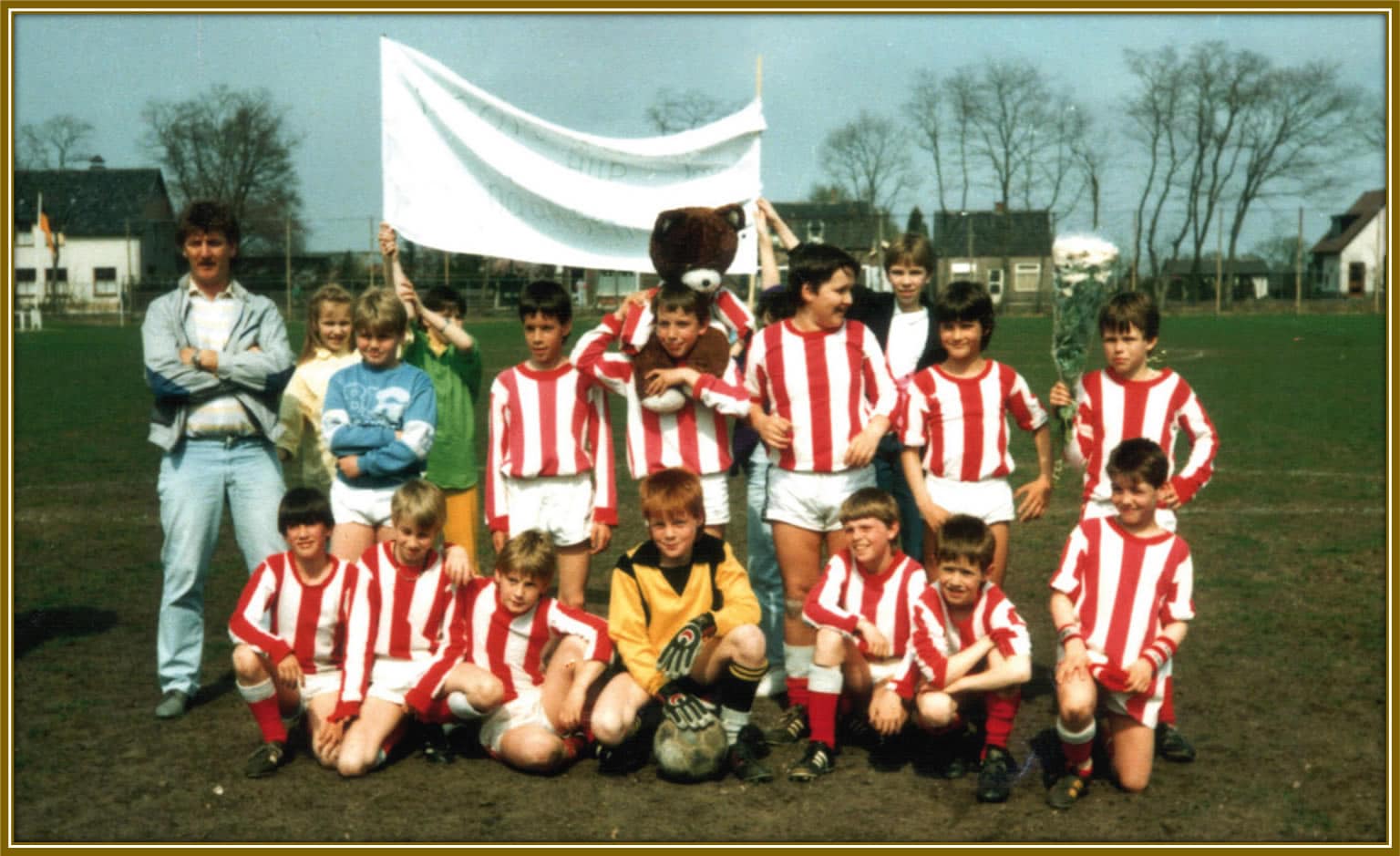
Can you spot the young Ruud van Nistelrooy in this nostalgic team photo? A hint: he’s in the top row, third from the left, standing tall among his Nooit Gedacht teammates.
Name Background:
Ruud van Nistelrooy’s last name has an interesting history tied to his roots and career. It originates from Nistelrode, the village in the Netherlands where his distant ancestors lived. His family name was originally spelt Van Nistelrooij. However, Ruud made a small but significant change when he began playing abroad.
He altered the spelling to Van Nistelrooy to simplify pronunciation and meet practical needs. The Dutch letters “ij” are unfamiliar and challenging for non-Dutch speakers. The change also helped with the naming on football shirts when he transferred to foreign clubs.
At Manchester United, another challenge arose: his long surname didn’t fit on the children’s shirts. The club had to specially order smaller letters to accommodate the high demand for his jerseys. On standard shirts, his name appeared as “v. Nistelrooy,” which initially puzzled some fans in England. Many didn’t know what the “v” stood for until they became more familiar with his Dutch heritage. This adaptation shows how Ruud adjusted even small details to fit into the global football stage.
Family Origin:
Ruud van Nistelrooy’s roots trace back to the village of Nistelrode, located in the Dutch province of North Brabant. This historic village, first mentioned in the 13th century as Nisterle, became an independent parish in 1291. Over centuries, Ruud’s ancestors called this place home, and it remains a small but vibrant community with a population of 5,455 as of 2021.
The connection between Ruud’s surname, Nistelrooij, and the village name, Nistelrode, highlights his family’s deep ties to their heritage. It’s likely his parents named him with pride, reflecting their roots in this centuries-old settlement.
A prominent landmark in Nistelrode is the Catholic St. Lambertus Church, constructed between 1841 and 1842 in neoclassical style. It replaced an earlier chapel from 1340, standing as a testament to the village’s enduring history.
For a closer look, maps and images reveal more about this picturesque village that played a significant role in shaping the identity of one of football’s legends.
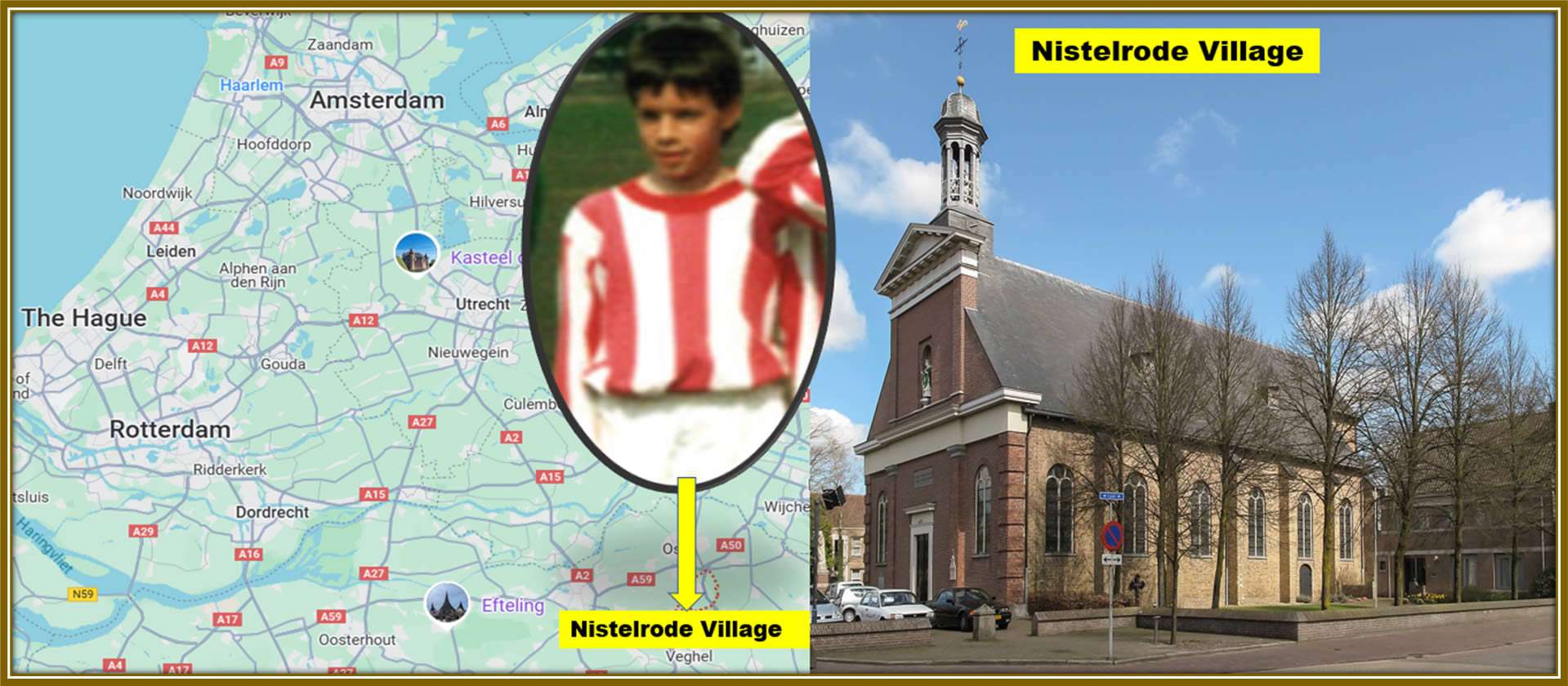
Tracing Ruud van Nistelrooy’s roots: A glimpse at his hometown, Nistelrode, shown on the map alongside a childhood photo of young Ruud and the historic Catholic St. Lambertus Church, a landmark steeped in history since 1842.
Ethnicity:
Ruud van Nistelrooy is of Dutch ethnicity, hailing from the Netherlands. He was born in Oss, a city in North Brabant, a province known for its rich history and culture. His ancestry ties him to the village of Nistelrode, reflecting deep Dutch roots passed down through generations. His name, “Van Nistelrooij,” connects him directly to this heritage.
Ruud van Nistelrooy Biography: Football Story:
Ruud van Nistelrooy’s talent began to shine early when he played for FC Den Bosch in a youth tournament final against Randers Freja from Denmark. Despite his team’s loss, his performance stood out. Football was always his priority, and he was determined to help his team succeed. The following year, on May 3, 1994, at just 17 years old, Ruud made his professional debut for FC Den Bosch in an away match against ADO Den Haag, a club that would later produce talents like Sem Steijn and Joshua Zirkzee.
As Ruud van Nistelrooy began his professional career, things didn’t go as expected. His scoring ability wasn’t immediately visible at FC Den Bosch. The main reason was that Ruud wasn’t playing in his natural striker position. Instead, his teammate Anthony Lurling was the one finishing chances and scoring goals from the wing.
In the 1995/1996 season, Ruud van Nistelrooy struggled to find the net, scoring no more than two goals in 21 matches. He didn’t yet prove himself as a goal-scoring striker. However, in his final season at FC Den Bosch, he pushed for a more fitting role on the pitch. This paid off, as Ruud scored 12 goals in 31 matches, showcasing his true potential. His performances caught the attention of Foppe de Haan, the coach of SC Heerenveen, and several clubs showed interest. Ultimately, Ruud chose SC Heerenveen as the next step in his career.
SC Heerenveen
Ruud van Nistelrooy spent eight years at FC Den Bosch, playing six years in the youth team and four seasons in the first team. In 1997, he moved to SC Heerenveen for 600,000 guilders (€360,000). Motivated by his improvements in his final season at Den Bosch, Ruud made an immediate impact at SC Heerenveen. He transitioned from midfield to striker and quickly gained recognition as a rising star in Dutch football. In his first Heerenveen season, he scored 13 goals in 31 matches under coach Foppe de Haan, helping the club qualify for European football. His performances earned him a spot in the Netherlands under-21 team.
PSV
Ruud’s impressive performances caught the attention of Dutch giants PSV. On his 22nd birthday in 1998, he signed a contract with the club for a record transfer fee between two Dutch teams. In his first season at PSV, Ruud made an instant impact, scoring an incredible 31 goals. His goal-scoring prowess earned him the title of top scorer in the Netherlands and a spot on the Dutch national team on 18 November 1998. His success continued in 1999 when he was named ‘Footballer of the Year’ and received the Silver Shoe as Europe’s second top scorer.
In his second season at PSV (1999-2000), Ruud kept up his impressive goal-scoring form, netting 29 goals. He was chasing the record for most goals in a single season, held by Coen Dillen, who scored 43 goals. Unfortunately, a serious knee injury sustained during a friendly against Silkeborg on 6 March 2000 prevented him from breaking the record. Despite this setback, Ruud finished as the top scorer in the Netherlands once again and was named Footballer of the Year in the Eredivisie.
Journey to Manchester United:
In April 2001, rumours began about Ruud van Nistelrooy’s move to Manchester United. The club quickly took the lead in negotiations with his agent, Roger Linse. To show his commitment, Sir Alex Ferguson personally travelled to the Netherlands on April 8 to watch Ruud in action during the Ajax-PSV match. This visit made it clear how much United wanted him.
Negotiations with Roger Linse continued until late April. On April 23, Reuters announced, “Van Nistelrooy to Manchester United.” The transfer fee of 67 million guilders (30.4 million euros) was a record in the Premier League at the time. At 25, Ruud signed a five-year contract and joined United’s strike force, which included the iconic duo Dwight Yorke and Andy Cole, both 30. Sir Alex Ferguson wanted younger strikers, leading to the arrivals of Ruud and 23-year-old Diego Forlán.
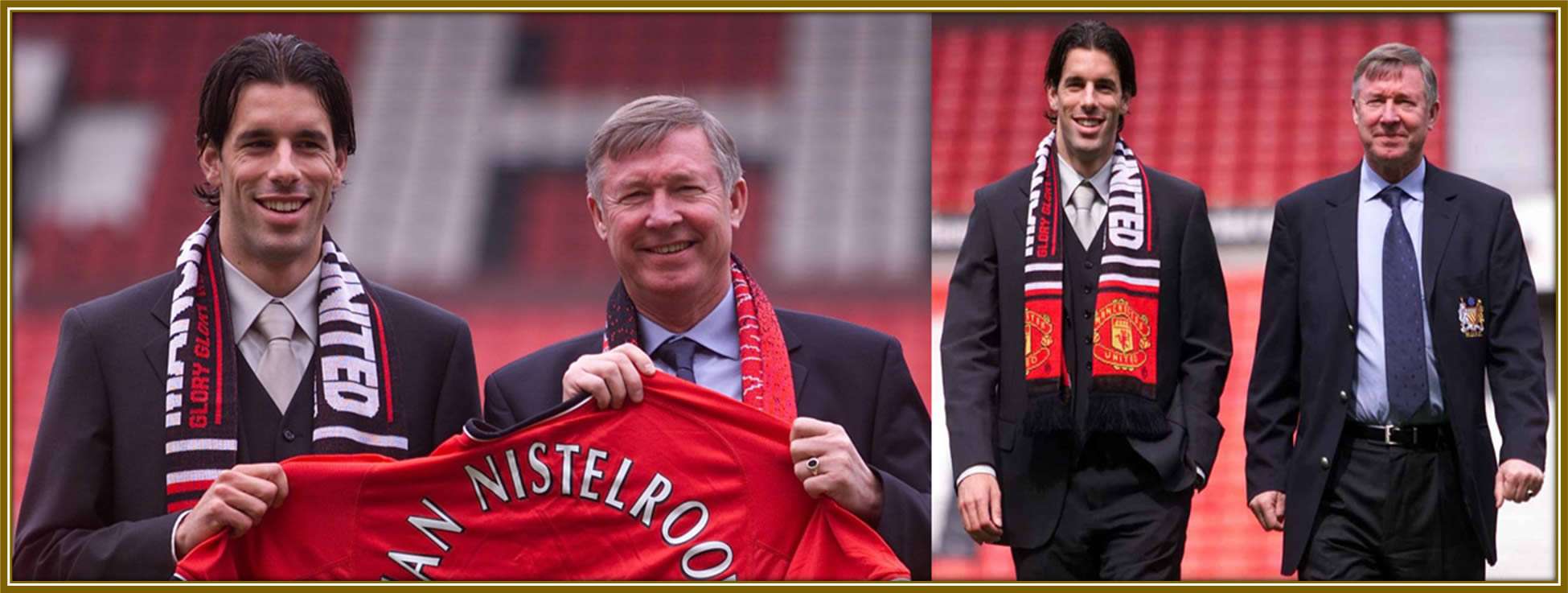
Sir Alex Ferguson beaming with delight as he completes the signing of Ruud van Nistelrooy, marking the beginning of a successful partnership at Manchester United. Credit: ManchesterUnited, SkySports
Early United Years:
Ruud van Nistelrooy played alongside notable players like Paul Scholes, his fellow Dutchman Jaap Stam, and the legendary Roy Keane. When he joined Manchester United, Ruud realized his full name might be difficult for English fans to pronounce. His original name, Rutgerus Johannes Martinus van Nistelrooij, was shortened. He decided to go by “Ruud” instead of Rutgerus and simplified his surname from “van Nistelrooij” to “van Nistelrooy.”
The change of surname became even more necessary when “van Nistelrooij” didn’t fit on kids’ Manchester United jerseys. After the adjustments, much to Sir Alex Ferguson’s delight, Ruud quickly got to work for United. In his first season, he proved his worth by scoring 36 goals, earning him the Player of the Year award from Premiership players. Ruud also became the top scorer in the UEFA Champions League that season.
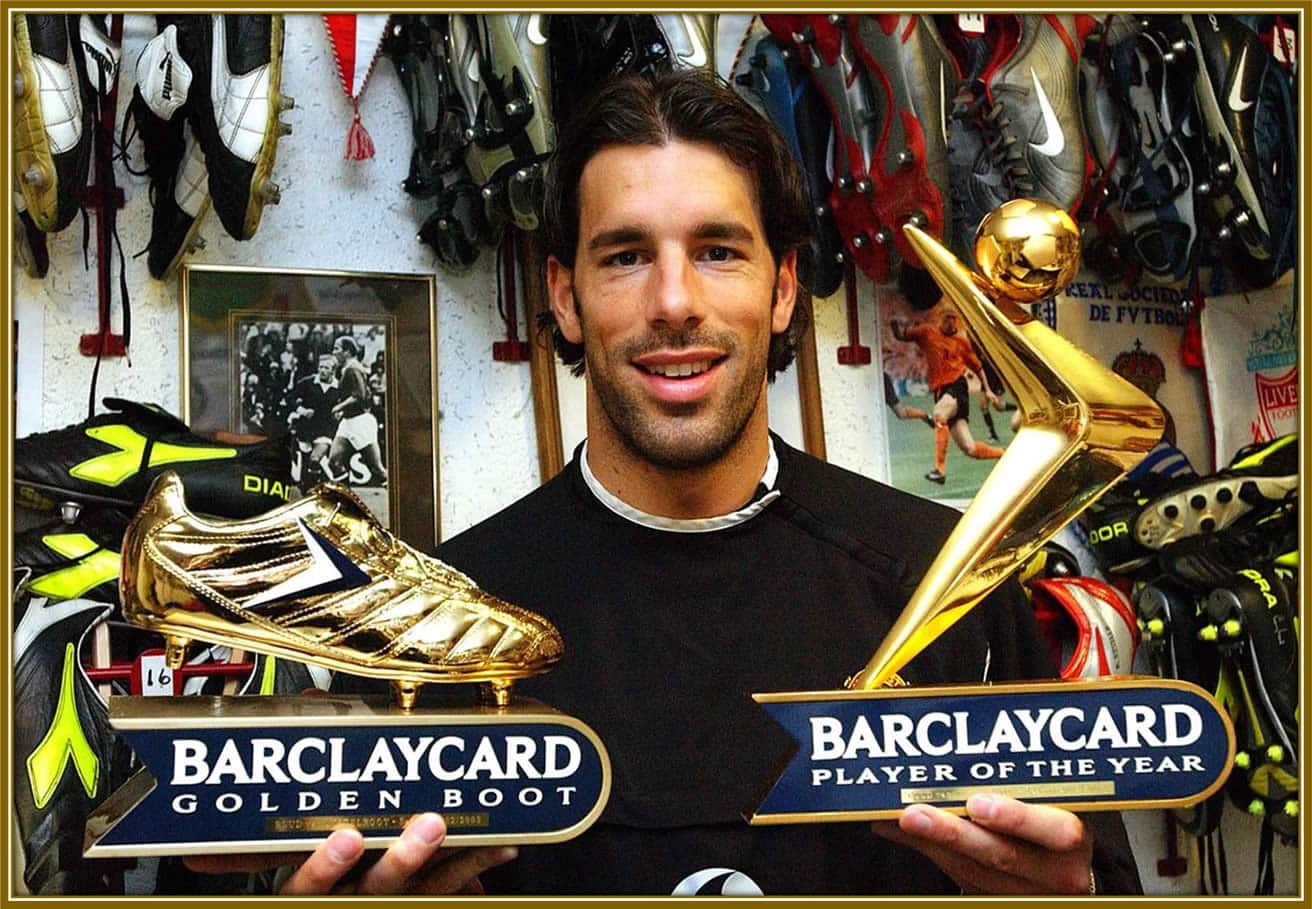
Ruud van Nistelrooy proudly smiling as he holds the Barclays Golden Boot and Player of the Year awards, celebrating his outstanding achievements on the field. Credit: ManchesterEveningNews.
In his second season, Ruud van Nistelrooy’s goal tally soared to 44, helping Manchester United win the 2002–2003 Premier League title. He once again finished as the top scorer in both the league and the Champions League. During the 2003–2004 season, Ruud set a Premier League record by scoring in ten consecutive games. This streak remained unmatched until Jamie Vardy broke it in 2015 with 11 consecutive goals. One of Ruud’s most memorable goals came against Fulham. Starting from the halfway line, he dribbled past five defenders before beating the goalkeeper with a stunning sliding finish. It remains one of his finest moments at United.
When things began changing:
On August 12, 2003, less than a week after an impressive friendly performance, Manchester United signed Cristiano Ronaldo for £12 million. Less than a year later, Chelsea brought in José Mourinho and Didier Drogba, who had a clear goal—dethroning Ruud van Nistelrooy as the Premier League’s top scorer.
This marked the start of a new era in English football. Mourinho’s arrival came with bold statements, including his famous line: “Please don’t call me arrogant, but I’m a European champion, and I think I’m a special one.” His confidence signalled a major challenge for United. Suddenly, Ruud and his team weren’t just up against Arsenal anymore—they now faced a serious contender in Chelsea, determined to disrupt their dominance in the league.
On August 12, 2003, Sir Alex Ferguson’s Manchester United signed Cristiano Ronaldo for £12 million, marking the start of a new era at the club. At the time, Ruud van Nistelrooy was the biggest name in English football. However, he had no idea that the 18-year-old boy sitting next to him during a visit to a children’s hospital would one day surpass him to become the club’s biggest star—and a global icon in football.
What Ruud also couldn’t foresee was the bitter rivalry that would develop between him and Ronaldo. Their relationship soured, partly due to Ruud’s harsh comments about Ronaldo’s late father, which deepened the rift between the two.
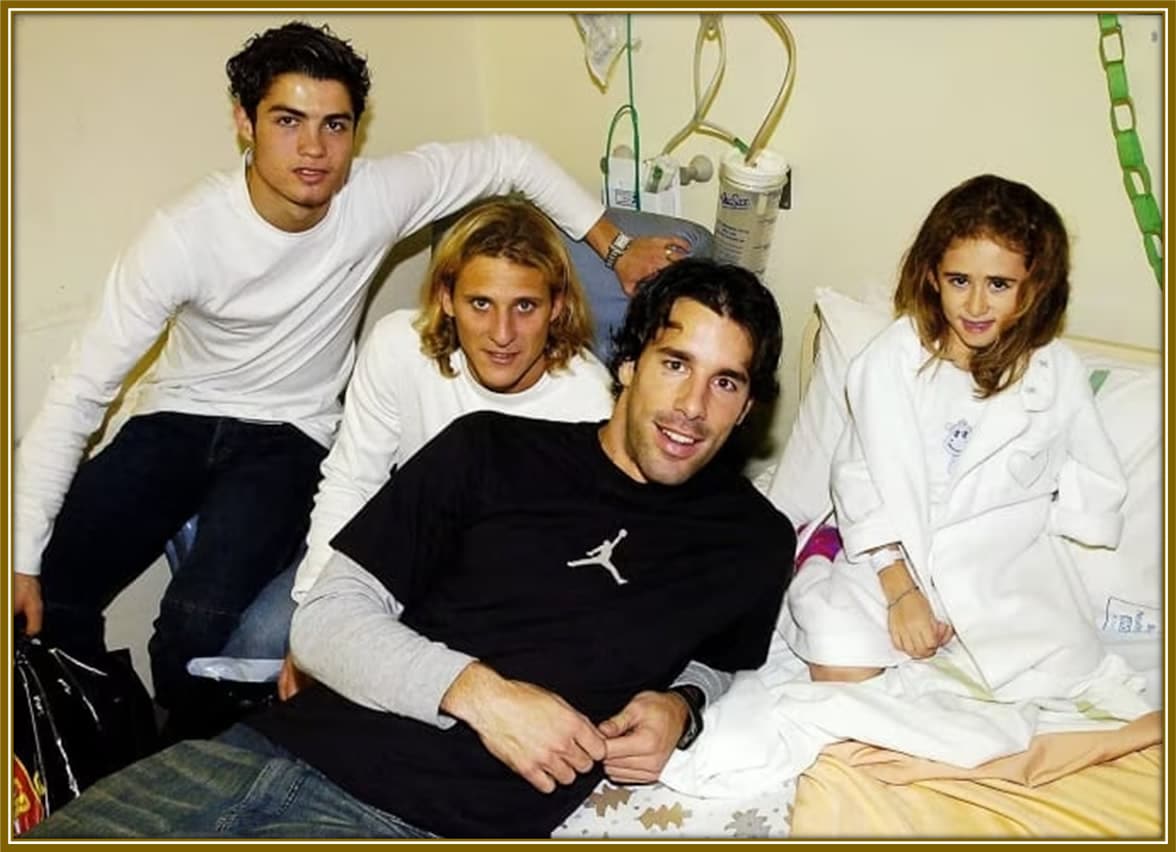
Ruud van Nistelrooy, a very young Cristiano Ronaldo, and Diego Forlán, at a children’s hospital in Manchester, sharing a moment of kindness off the pitch.
Career Incidents:
Ruud van Nistelrooy’s first major incident in English football involved Arsenal, in what came to be known as “The Battle of Old Trafford.” During Arsenal’s historic Invincibles season, their goal was not just to dominate the league but to assert their supremacy over Manchester United. Matches between the two clubs were always intense, often erupting into fights and heated exchanges—and Ruud frequently found himself at the centre of the drama.
In September 2003, United faced Arsenal in a Premier League clash. The tension boiled over when Arsenal’s Patrick Vieira clashed with Ruud after a tough tackle by the Dutch striker. The confrontation set the tone for what would become one of the most fierce and iconic rivalries in English football history.
The drama escalated when Patrick Vieira, already on a yellow card, received a second booking and was sent off. Arsenal players were livid, believing Ruud van Nistelrooy had played a role in Vieira’s dismissal. The tension peaked in injury time, with the score locked at 0–0. Van Nistelrooy saw a chance to win the match with a penalty but struck the crossbar.
What followed became infamous. Arsenal players, led by Martin Keown, charged at Van Nistelrooy, shouting in his face. Keown’s arm even grazed the back of Ruud’s head, but the Dutchman stayed calm and walked straight into the players’ tunnel.
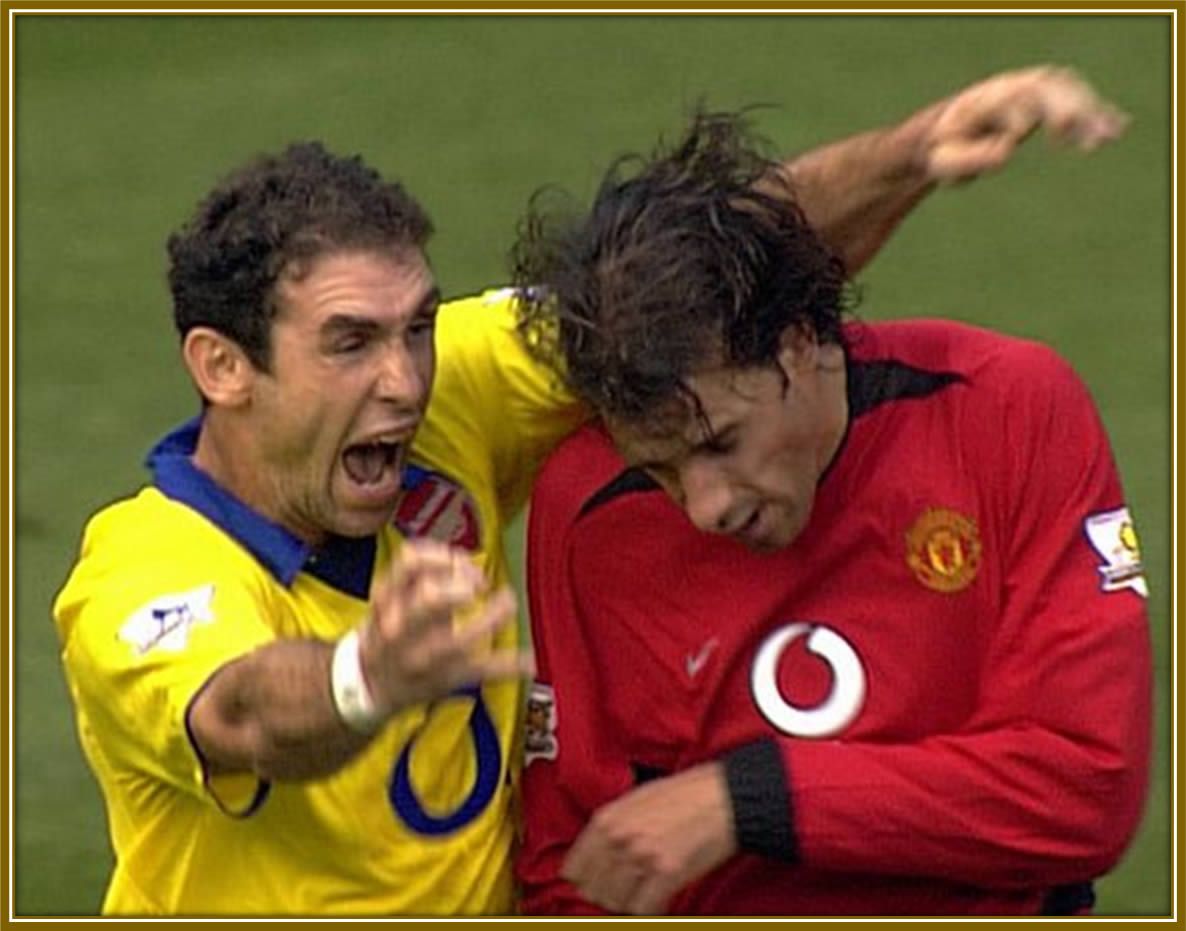
Ruud van Nistelrooy vs. Martin Keown: Reliving the fiery Arsenal vs. Man Utd battles, filled with drama, rivalry, and unforgettable moments! Image: Skysports
This heated moment added more fuel to the bitter rivalry between Manchester United and Arsenal. The English Football Association eventually had to step in to address the fallout from the incident.
Incidents outside Manchester United:
During a Euro 2004 qualifying match against the Czech Republic, Ruud van Nistelrooy was substituted by coach Dick Advocaat. Furious with the decision, he kicked a water bottle in frustration, directing his anger toward Advocaat.
Later, during the tournament’s semi-final, Van Nistelrooy found himself in trouble again. He reportedly insulted referee Anders Frisk, calling him a “home whistler.” As a result, he was handed a two-match suspension. Although the Royal Dutch Football Association (KNVB) considered appealing the decision, they ultimately decided not to pursue it further.
During a World Cup 2006 qualifying game between the Netherlands and Andorra (which ended 4-0), Ruud van Nistelrooy endured rough treatment from the Andorran defenders, especially Antoni Lima, who tackled him hard throughout the match. After missing a penalty, Lima mocked Van Nistelrooy by laughing in his face.
Ruud got his revenge in style. He scored the fourth goal for the Oranje Holland, then walked up to Lima, cheering directly in front of him. This show of defiance earned him a yellow card, but Van Nistelrooy had taken his sporting revenge.
Incidents with Manchester United teammates:
During the 2005-2006 season, Van Nistelrooy had a fight with coach Ferguson for unclear reasons. During the League Cup final match against Wigan Athletic, the Dutch striker was kept on the bench for 90 minutes in favour of Louis Saha. Because of the troubles between him and his coach, Ruud decided to leave Manchester United for the training camp of the Dutch national team earlier in preparation for the 2006 FIFA World Cup.
During the World Cup, he was asked about his issue with Sir Alex Ferguson and Ruud van Nistelrooy responded it that was just a ‘difference of opinion’ between him and Ferguson. The Manchester United coach wasn’t happy about the comment, so, after the World Cup, he announced that Van Nistelrooy was free to go.
Again, for the first time, Van Nistelrooy got into a fight with Cristiano Ronaldo because the latter had allegedly not passed the ball quickly enough during a match. Further conflict arose when Ferguson did not let Van Nistelrooy come on as a substitute during the final of the Carling Cup.
The second issue with Cristiano Ronaldo:
The tension between Ruud van Nistelrooy and Cristiano Ronaldo began when Van Nistelrooy made a hurtful comment about Ronaldo’s late father. Rumors had already spread about a rift between Van Nistelrooy and Sir Alex Ferguson, but this comment seemed to be the final straw.
Van Nistelrooy allegedly told Ronaldo that he had found a new father in Carlos Queiroz, Ferguson’s assistant, shortly after Ronaldo’s father passed away from alcoholism in June 2006. This remark deeply affected Ferguson, who started to see Van Nistelrooy as self-centred. It was widely believed that this incident played a major role in Van Nistelrooy’s eventual departure from Manchester United.
When Carlos Queiroz heard about Van Nistelrooy’s comment, he summoned the Dutch striker and advised him to respect Ronaldo’s situation and his family’s grief. Van Nistelrooy, however, responded harshly, stating that he had no respect for anyone at Manchester United. While Van Nistelrooy later apologized to Ronaldo, the Portuguese forward refused to forgive him.
Before this incident, Van Nistelrooy and Ronaldo had been close friends, both on and off the pitch. Ronaldo looked up to Van Nistelrooy, and the two shared moments of celebration when they won together. Ronaldo would often passionately hug Ruud and show signs of respect every time the Dutch striker scored. However, this fallout marked the end of their friendship and played a significant role in Van Nistelrooy’s departure from the club.

Ruud van Nistelrooy and Cristiano Ronaldo sharing a moment of celebration on the pitch, a symbol of their close friendship and mutual respect before their eventual fallout. Image Credit: HeldenMedia
Path to Real Madrid:
After the issue with Cristiano Ronaldo, rumours circulated that Ruud van Nistelrooy would leave Manchester United for Real Madrid, which turned out to be true. At the time, Sir Alex Ferguson was known not only as a top motivator and coach but also as a master in managing transfers. In 2006, he decided it was time for Ruud to go. The decision didn’t sit well with the Dutch striker, who felt his teammates and manager began viewing him differently, as though the trust they once had in him had faded.
At that time, the only support Ruud van Nistelrooy felt came from the Manchester United fans, who still saw him as their Goal King. However, he felt he was being forced out of the club, and it took a toll on his mental health. Even when asked to play matches to boost his market value for a transfer, Ruud realized he was completely drained. After 219 games in five years in the Premier League, his body simply couldn’t keep up anymore. Reflecting on his time at United, he realized he had never truly had a proper break since joining the club.
In his words:
“I never had Christmas and New Year’s Eve off, as Sir Alex always demanded my presence during those times. I also noticed I was playing sixty to seventy games a year with the club, plus international matches, which was too much for me. Those games drained me both mentally and physically. I was truly exhausted, and I couldn’t do it anymore. My mind was ready for something new, and I could tell that Ferguson sensed that too.”
Real Madrid:
In the end, Ruud van Nistelrooy had to choose between Real Madrid and Bayern Munich. He decided it was the perfect time to take a big step in his career and joined the Spanish giants. At Real Madrid, he played alongside stars like Brazilian Ronaldo, Robinho, Juan Mata (then just 19), Raul, Roberto Carlos, Sergio Ramos, Marcelo, and Fabio Cannavaro.
At Real Madrid, Ruud van Nistelrooy reunited with David Beckham. He noticed that Beckham continued doing what he did at Manchester United—building his brand. On the pitch, their connection remained strong. Beckham was still the player who could deliver the ball exactly where Ruud wanted it. However, off the pitch, their lives were very different.
Ruud van Nistelrooy recalled a moment during his first season at Real Madrid before a big game. He mentioned having a few friends coming over, and Beckham casually said his “mates” were coming too. Curious, Ruud asked who Beckham meant. Beckham replied, “Tom, from LA.” Ruud asked, “Which Tom?” Beckham said, “Oh, Tom Cruise.” After the game, they went to dinner, and Ruud found himself sitting at the table with Tom Cruise. For Beckham, meeting high-profile U.S. celebrities was completely normal.
At Real Madrid, Ruud van Nistelrooy won two La Liga titles (2006–07, 2007–08) and the 2008 Supercopa de España. When the club shifted focus to younger players like Gonzalo Higuaín and Karim Benzema, Ruud realized his time there was ending. Injuries didn’t help—he suffered a partially torn meniscus in his right knee, requiring a second operation with a recovery time of six to nine months. Ruud left Real Madrid the same season Cristiano Ronaldo arrived. He later played for smaller clubs, Hamburger SV and Málaga, before retiring at 35.
Journey to Managerial Fame:
Ruud van Nistelrooy stayed in football after retiring as a player, pursuing a coaching career. In February 2014, it was announced he would become assistant coach to Guus Hiddink with the Dutch national team after the 2014 World Cup. He served as second assistant, while Danny Blind was first assistant. When Hiddink left, Van Nistelrooy continued as assistant under Danny Blind. Two years later, he began coaching PSV’s youth team and eventually became head coach of Jong PSV, the reserve team. When Roger Schmidt left PSV’s first team, Van Nistelrooy was considered as his replacement. At first, he declined but later accepted, signing a contract until mid-2025.
With PSV, Ruud van Nistelrooy achieved success, winning the KNVB Cup by beating Ajax on penalties. He also won the 2022 Johan Cruijff Shield with a 3–5 victory over Ajax in Amsterdam. On May 23, 2023, discussions began about improving his contract, but Ruud resigned immediately, citing a lack of support from the club. Before leaving, he played a key role in developing young talents like Ki-Jana Hoever (RB), Xavi Simons (AM), Cody Gakpo (LW), Savinho (LW), Fábio Silva (CF), and Noni Madueke (RW).
Manchester United Second Coming and Beyond:
On July 11, 2024, Ruud van Nistelrooy signed a two-year deal to become an assistant manager at his former club. He joined as Erik ten Hag’s right-hand man and was warmly welcomed. When Ten Hag was dismissed on October 28, 2024, after a poor start to the season, Nistelrooy stepped in as interim head manager. Fans were thrilled to see their legend back, hoping he could help restore the club’s glory days.
Ruud started strong as interim manager, with a 5–2 win over Leicester City and a Premier League draw against Enzo Maresca‘s Chelsea. On November 1, 2024, Rúben Amorim was named the new manager, and it was announced Ruud would not join Amorim’s technical staff. After leaving Manchester United, several clubs, including Burnley and Hamburger SV, showed interest in him. Leicester City, the team he had recently beaten, won the race to make him their head coach. The rest is history.
How It Began for Ruud and His Wife, Leontien Slaat:
Ruud and Leontien met in their final year of secondary school when they were both 19. They were classmates for the last two years and helped each other with exams. After their final test, Ruud realized he missed her, and they decided to meet up. That led to the start of their relationship. Leontien continued her studies in marketing management and communication, while Ruud focused on football. However, in 2001, she chose to leave her academic career behind and moved with Ruud to England.
Ruud van Nistelrooy’s mother once told Leontien that she wouldn’t be able to continue her work if she moved abroad with Ruud. At the time, Leontien hadn’t considered living abroad. She had always planned to pursue something with her studies.
Her lack of consideration for moving abroad was partly due to her upbringing. When they started dating, Ruud would visit her family on Sunday evenings, expecting to watch Studio Sport, but they would watch Van Kooten & De Bie instead. He found it strange that her family had no interest in football. In fact, Ruud recalled they were the first people he met who didn’t watch Studio Sport on Sundays.
For Leontien, the idea of a life with a footballer abroad was far from her mind.
Getting Leontien’s full support:
Looking back, Ruud realizes that all his transfers—from PSV to Manchester, Manchester to Madrid, Madrid to Hamburg, and finally to Malaga—required more adjustment from his immediate environment than from him as a footballer. Leontien had to end her career abruptly but took the time to understand football while always supporting him 100%.
When Ruud moved from Manchester to Madrid, Leontien was eight months pregnant with their first child. Now, the couple is the proud parents of two children. Throughout all the hustle and bustle with Ruud, his teammates, and manager Sir Alex, Leontien has always remained herself. She never sought the spotlight.

Ruud van Nistelrooy and his wife Leontien, proudly posing with their child, sharing a beautiful family moment.
Ruud van Nistelrooy’s Wedding:
In 2004, Ruud van Nistelrooy married his childhood sweetheart, Leontien Slaat. The wedding took place in Geffen at the Holy Magdalena church. Ruud had hoped to keep the ceremony private, but the press quickly caught wind of it and showed up in large numbers. Fans and well-wishers lined the route to the church, including around 60 students from the “Nooit Gedacht” football club. Hundreds of supporters also gathered outside the town hall in Heesch to greet the couple. Afterwards, they attended a Catholic service with family and friends at the church.
Ruud van Nistelrooy’s boss, Sir Alex Ferguson, attended the wedding, along with some of his Dutch teammates. Local junior footballers from the Nooitgedacht club, where Ruud first played, gave him a guard of honour. As the couple arrived in a white Rolls-Royce, a crane hung a huge shirt in the club’s colours over the village square. The groom wore a beige suit, and his bride, Leontien, wore a traditional white dress. The wedding kiss between Ruud and Leontien was a memorable moment.
Ruud later recalled the day:
“Getting married was a big deal in Heesch. It was right after the European Championship in Portugal, and there we were, the 28-year-old prince and his princess. I was already playing for Manchester United, and though the press wasn’t informed by us, they were there. The square was full, with barriers everywhere. We just thought, ‘Let’s give each other a kiss.'”
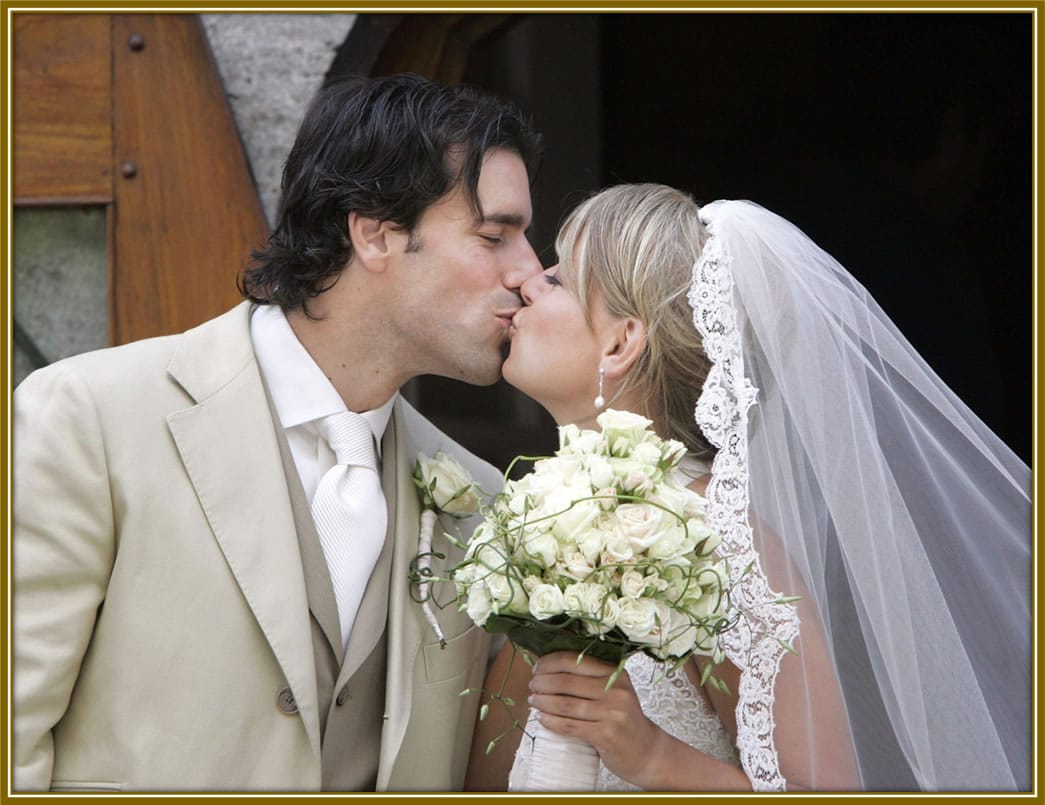
Ruud van Nistelrooy and his wife, Leontien, share a joyful kiss on their wedding day, celebrating their love in front of family, friends, and fans. Image Credit: Helden Media.
Untold Facts:
In the final section of Ruud van Nistelrooy’s Biography, we’ll unveil truths you might not know about him. Without further ado, let’s get started.
His Hobby Outside Football:
While Ruud van Nistelrooy is celebrated as a football legend, few know about his cherished hobby outside the sport. It’s not tennis or gymnastics, which he loved as a child, but ice skating. Ruud often visits the Tiroler Zugspitz Arena, a perfect holiday spot for outdoor enthusiasts. This region offers breathtaking views and ski resorts with numerous slopes, served by 58 lifts and cable cars. Surrounded by four majestic mountain ranges, it’s an ideal getaway for hikers like Ruud, who enjoy being immersed in nature.
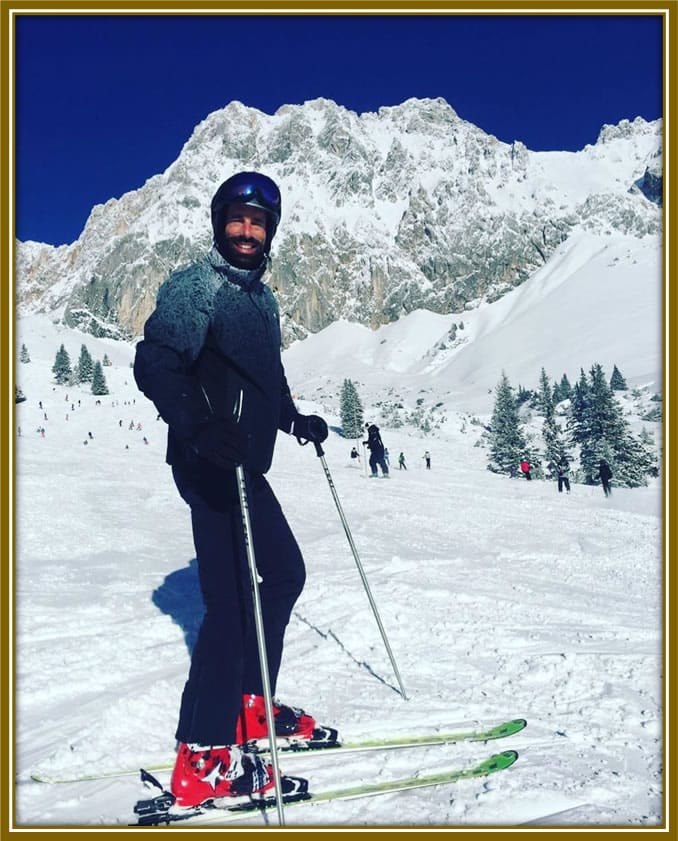
van Nistelrooy enjoying a thrilling moment skiing on ice, showcasing his passion for outdoor adventures beyond football.
What would Ruud van Nistelrooy’s FC25 or FIFA Profile would be during his Prime:
At the height of his career at Manchester United, the Dutch striker Ruud van Nistelrooy would have been a dream player in FIFA’s career mode. Many gamers who missed the chance to play him on Football Manager might not realize just how incredible his stats would have been. Ruud had all the key attributes a top striker needs—finishing, reactions, heading accuracy, attacking positioning, and penalty skills. At his peak, he boasted an impressive 93 overall rating and 94 potential. His playing style brings to mind modern greats like Karim Benzema and Robert Lewandowski during their prime years.
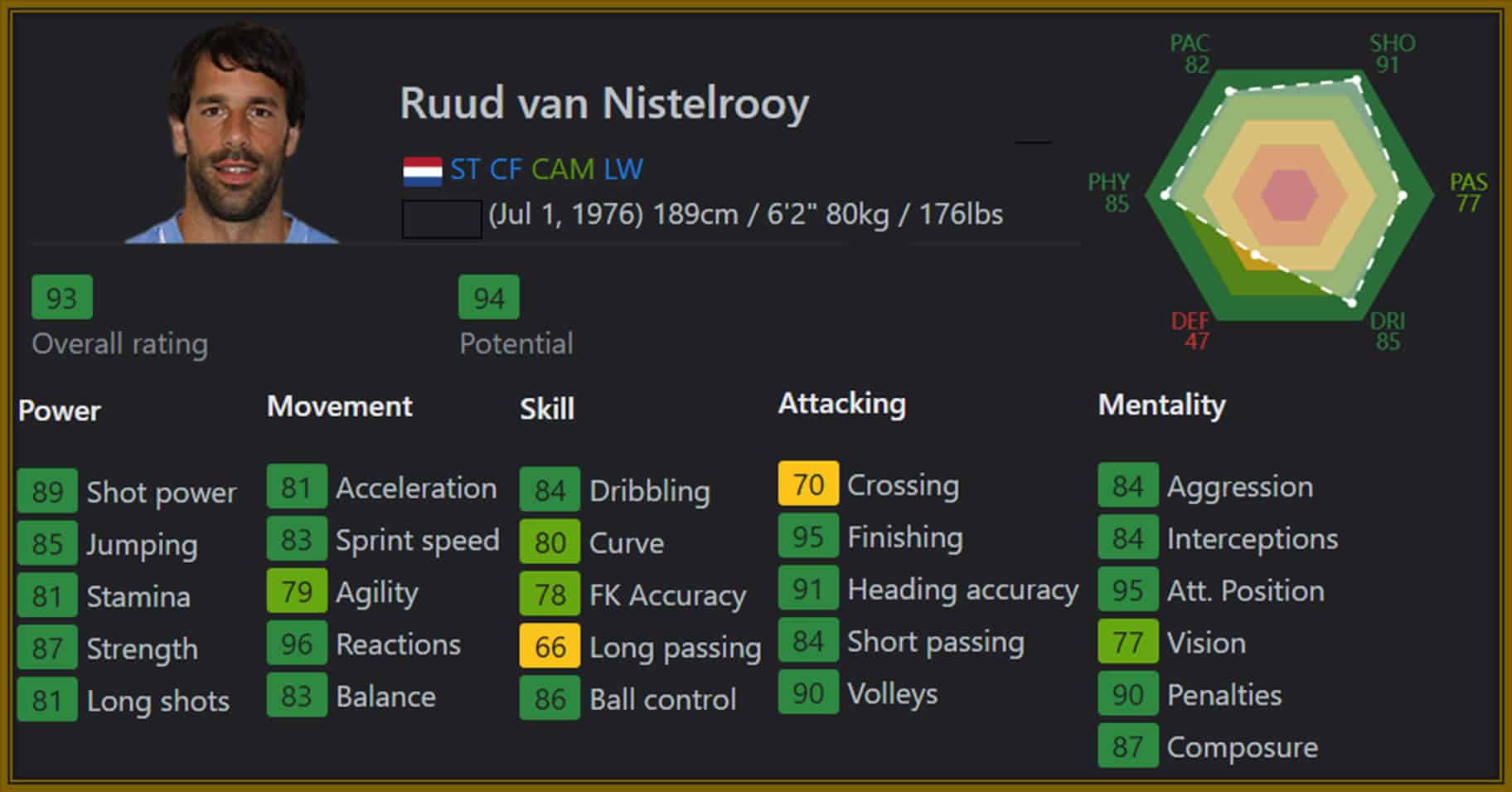
Ruud van Nistelrooy’s impressive FIFA stats showcase his prime attributes, including exceptional finishing, heading accuracy, and attacking positioning. Credit: SOFIFA
What is Ruud van Nistelrooy’s Religion?
Ruud van Nistelrooy, the Manchester United legend, is a devout Roman Catholic and a committed Christian. He is one of the few prominent football coaches with strong religious roots. Interestingly, his birthday mate Patrick Kluivert, also a devout Christian, shares a similar background. Kluivert, raised Catholic by his Dutch West Indian parents, was known for crossing himself on the pitch during his playing days.
In the Netherlands, immigrants have often shown deeper religious devotion than native inhabitants. However, Ruud, hailing from the Catholic heartland south of the great rivers, also crosses himself and holds his faith dear. Reflecting on his beliefs, he once said:
“I was raised a Catholic, was baptized, did Communion. I think there is something bigger that we can’t see. But that can be anything. It doesn’t have to be the God of the Roman Catholic Church.”
End Note:
Ruud van Nistelrooy’s journey from a small town in the Netherlands to becoming one of the world’s top strikers is a testament to his hard work and determination. Born into a family with strong values, Ruud’s early years were marked by a love for football, which was nurtured in his hometown of Heesch. He began his career at FC Den Bosch before moving to SC Heerenveen, where his goal-scoring abilities were finally recognized. His time at PSV Eindhoven, where he became a star, paved the way for his successful stints at Manchester United, Real Madrid, Hamburg, and Málaga.
Off the pitch, Ruud found stability and love with his childhood sweetheart, Leontien Slaats, whom he married in 2004. Despite the challenges of moving countries and adapting to different football cultures, Leontien supported Ruud through it all. Together, they have built a family, remaining grounded despite the fame and demands of his football career. Ruud’s story is one of resilience, dedication, and the importance of family.
Appreciation Note:
Thank you for reading this article about Ruud van Nistelrooy, one of football’s most feared strikers. We aim to provide accurate and fair stories about some of the game’s celebrated retired players. You might also enjoy reading about Rivaldo and Adriano. If you notice anything inaccurate in this memoir about the Manchester United legend, feel free to share it in the comments. Let us know your thoughts on Ruud, his remarkable story, and his career!
